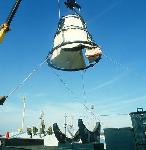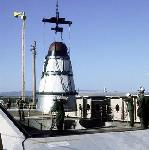





Each Titan II silo was directly connected to an underground launch control capsule manned by a missile combat crew of two officers and two airman. The Titan II, like the Titan I, had an effective range of ~approximately 5,500 nautical miles. The Air Force had approved the development of the Titan II ICBM in October 1959. By 28 March 1961, the missile force included six Titan I and six Titan II squadrons. SAC activated the first Titan II squadron on 1 January 1962 and during the next eight months activated five more squadrons.
On 8 June 1963, the 570th Strategic Missile Squadron at Davis-Monthan became the first Titan II unit to achieve operational status. Headquarters SAC completed the deployment of the second-generation ICBM weapon system on the last day of 1963 when it declared the sixth and last Titan II unit, the 374th Strategic Missile Squadron at Little Rock Air Force Base, Arkansas, operational.
By 1981, the Titan II weapon system had served the nation for eighteen years, eight years longer than its predicted service life. The system's advanced age, combined with three accidents that destroyed two sites and killed four airmen, had cast doubts on its safety and effectiveness. SAC, anticipating a Department of Defense (DOD) initiative, began to consider replacement options in October 1980. One month later, the Senate Armed Services Committee asked the Defense Department to prepare a formal Titan II safety report. SAC's replacement options review became the basis for the DOD safety report released in February 1981. The DOD study acknowledged Titan II's significant, albeit declining usefulness in preserving nuclear deterrence, and recommended deactivation of the Titan system as part of the ICBM modernization plan. During the interim, SAC would continue to improve Titan hardware and safety procedures.
On 2 October 1981, Deputy Secretary of Defense Frank C. Carlucci directed the retirement of the Titan II at the earliest possible time. The deactivation program, designated Rivet Cap, formally began with the removal from alert of site 571-6 at Davis-Monthan AFB, Arizona, on 30 September 1982. Titan II deactivation was completed on 23 June 1987 when technicians removed the last Titan II missile from its silo at Little Rock AFB, Arkansas. The era of liquid propellant ICBMs came to a close on 18 August 1987 with the inactivation of the last Titan II wing, the 308th Strategic Missile Wing at Little Rock AFB.
Specifications |
|























